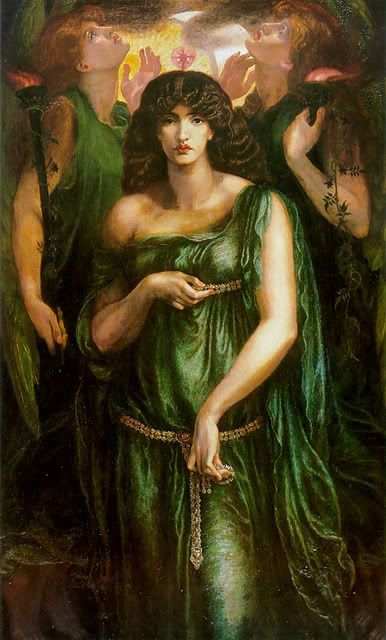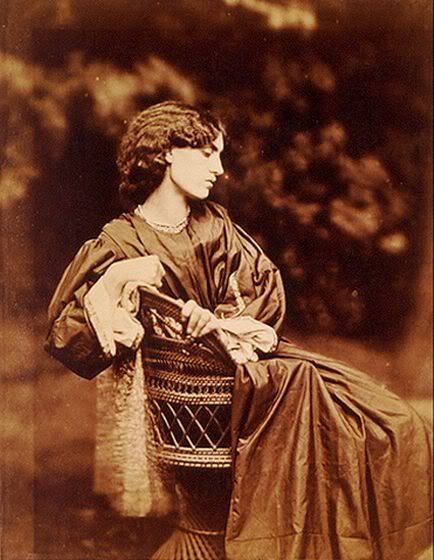
Painted between 1875 and 1877, Astarte Syriaca was originally entitled "Venus Astarte," in honour of the Syrian Love Goddess. Rossetti composed the painting on an immense six-foot (1.83 m) canvas, so that it was long enough for a full-length portrait. This is probably the most "revealing" portrait of Jane Morris, and its composition was partially based on Botticelli's The Birth of Venus.
The painting drew criticism when it was displayed, due to its erotic content. Victorian audiences were shocked by its overt sensuality. Venus' hands are positioned to draw attention to her fertility (use your imagination!), and are identical to the hand position of Botticelli's Venus. Furthermore, as Rossetti's poem (below) indicates, her girdle also highlights her voluptuousness("her twofold girdle clasps the infinite boon of bliss whereof the heaven and earth commune"). The girdle also functions in much the same way as the hair of Venus in Botticelli's version, but is a bit more subtle.
If you compare the way Jane looks in Rossetti's portrait (strong and sensual) to a photograph taken of her during roughly the same period, you can easily see that Rossetti has chosen to alter her appearance significantly. In fact, in a letter written a few years after Astarte Syriaca was finished, Jane complained to Rossetti that he probably didn't want to see her because she'd "grown too thin." Even at the time this painting was composed, you can see that she was hardly the robust figure that Rossetti painted. Nevertheless, isn't that what artistic license is for?
Rossetti wrote the following sonnet to accompany the painting:
Mystery, lo! betwixt the sun and moon
Astarte of the Syrians: Venus Queen
Ere Aphrodite was. In silver sheen
Her twofold girdle clasps the infinite boon
Of bliss whereof the heaven and earth commune:
And from her neck's inclining flower-stem lean
Love-freighted lips and absolute eyes that wean
The pulse of hearts to the sphere's dominant tune.
Torch-bearing, her sweet ministers compel
All thrones of light beyond the sky and sea
The witnesses of Beauty's face to be:
That face, of Love's all-penetrative spell
Amulet, talisman, and oracle,-
Betwixt the sun and moon a mystery.
Source Consulted: Tim Barringer. The Pre-Raphaelites. London: The Everyman Art Library, 1998.


15 comments:
Jane Morris did have an amazing face, didn't she?! I can see why Rossetti loved to paint her. I enjoyed reading the sonnet along with the painting. The green gowns are so lush...you can almost feel the smoothness of the fabric. And a very fertile color, don't you think?
Yes, indeed! The colours are so rich--Rossetti was an absolute master at creating deep, bright colours.
That Jane was such an inspiration to so many. Very enigmatic presence. I would love to have known her.
I know! I definitely wonder what she was like in real life.
It so interesting to me that the waif type of figure was transposed to the more voluptuous figure in this painting.
I like the idea of the accompanying sonnet to the painting too.
the painting is so real and beautiful...
Yes, Stephen! I find that very interesting as well. It's so weird when you think of the fact that today people spend hours airbrushing photos of models and actresses to make them appear SMALLER.
It is lovely, isn't it, m.kate? Rossetti was so amazing at making Jane "larger than life" in so many ways.
I don't know if you have ever seen Rossetti's self portrait? It shows surprisingly similar features to the women he paints. This is nothing unusual as it is believed that all artist's paint their own facial characteristics when they paint a portrait. I think it is because an artist observes and then adds his own knowledge of the world around him. The face we are most familiar with is our own.
Okay...I am not an expert...just a friend of Margaret's.I have never commented on a post before. Here goes. Further to what Acornmoon writes, the portrait really could be male or female.I see a male -a beautiful male At least I think so. Even today some of our most celebrated Hollywood beauties (ie. Brad Pitt) share the best qualities of both the sexes. The most masculine figure can be stunningly feminine. Here in the portrait I think we see the reverse. I've never seen it before but these are my initial thoughts when I looked at it.
Hey Marlon! Great to hear from you! Yes, he certainly makes her look rather masculine. (A lot of Rossetti's women do). Art critics have approached that issue in various ways--Griselda Pollack says Astarte Syriaca is symbolic "not of woman, but of that Other in whose mirror masculinity must definie itself." Not sure what I think about that. It sounds like a pretty daunting task though, if men have to be even more masculine that that! (She looks pretty intimidating to me!).
Acorn moon--I never really noticed that before, but you're so right! There is a lot of similarity between the features Rossetti highlighted in his own self-portrait and those of the female figures in his paintings. Really interesting!
Acorn moon--I never really noticed that before, but you're so right! There is a lot of similarity between the features Rossetti highlighted in his own self-portrait and those of the female figures in his paintings. Really interesting!
Now you've said it I can see the similarity between the Botticelli pose and this one. Isn't it weird you can know 2 paintings and still never see. :-) Thanks
I enjoyed your choice of paintings and the discussion. The detail and symbolism is fascinating. Such rich colours!
Thanks, Vivian. Yes, Rossetti's colours are always incredibly rich, aren't they?
Melanie--I'm kind of surprised I never noticed the similarity in positioning before! I only saw it after doing the post on Botticelli's Venus.
Post a Comment